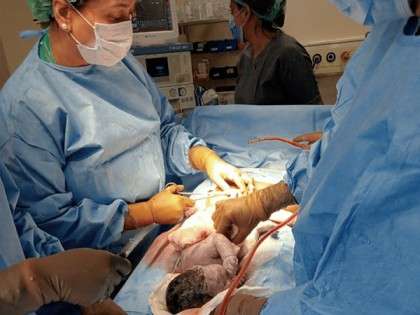Cesarean Section

Introduction
A C-section, or Cesarean section, is a surgical procedure used to deliver a baby through incisions made in the mother’s abdomen and uterus. This method of delivery is often performed when vaginal delivery would put the mother or baby at risk. Originally developed as a life-saving measure, the C-section has become a common procedure worldwide, accounting for approximately 30% of births in many countries. Understanding why and how C-sections are performed can help expecting parents prepare for the possibility of this type of delivery.
Reasons for a C-Section
C-sections may be planned in advance or performed as emergencies based on various medical indications:
Medical Indications:
- Fetal Distress: If the baby shows signs of distress, such as an abnormal heart rate, a C-section may be necessary to ensure the baby’s safety.
- Breech Position: When the baby is positioned feet-first or buttocks-first in the womb, a vaginal delivery can be risky.
Elective C-Sections:
- Some parents may opt for a C-section for personal reasons, such as scheduling convenience or fear of labor pain.
Emergency Situations:
- Labor Complications: Prolonged labor or failure to progress can necessitate a C-section.
- Umbilical Cord Prolapse: If the umbilical cord slips into the birth canal ahead of the baby, a C-section may be needed to prevent compression of the cord.
Preparation for a C-Section
Preparing for a C-section involves both physical and mental readiness:
Pre-Surgery Procedures:
- Medical Tests: Blood tests and other assessments will be conducted to ensure the mother is fit for surgery.
- Fasting: Typically, fasting for at least 8 hours before the surgery is required to reduce the risk of complications under anesthesia.
Anesthesia Options:
- Spinal or Epidural Anesthesia: Commonly used, allowing the mother to be awake without feeling pain in the lower body.
- General Anesthesia: Used less frequently, where the mother is put to sleep for the duration of the surgery.
The Procedure
A C-section involves several steps and typically takes about 45 minutes to an hour from start to finish:
Preparation:
- The mother is taken to the operating room, where she is prepped and anesthesia is administered.
- Sterilization of the abdominal area is performed to reduce infection risk.
Incision:
- A horizontal incision, about 10 cm long, is made in the lower abdomen, just above the pubic hairline (often called the “bikini cut”).
- Another incision is made in the uterus to allow access to the baby.
Recovery After a C-Section
Recovery from a C-section involves several stages, each requiring specific care and attention:
Immediate Post-Surgery Care:
- Recovery Room: After the surgery, the mother is moved to a recovery room for monitoring. Vital signs, including heart rate, blood pressure, and oxygen levels, are closely observed.
- Pain Management: Pain relief is administered through medication, either via an epidural, IV, or orally.
Hospital Stay:
- Duration: The typical hospital stay after a C-section is 3-4 days, but it can vary based on the mother’s and baby’s health.
- Monitoring: Continuous monitoring of the incision site, bleeding, and signs of infection. The baby is also checked for normal vital signs and feeding ability.
Risks and Complications
While C-sections are generally safe, there are some risks and potential complications:
Common Risks:
- Infection: The incision site or the uterus can become infected.
- Bleeding: There is a risk of excessive bleeding during or after the surgery.
- Blood Clots: Formation of blood clots in the legs or lungs is a concern.
Rare Complications:
- Injury to Organs: Nearby organs, such as the bladder or intestines, may be accidentally injured during surgery.
- Reactions to Anesthesia: Some individuals may experience adverse reactions to anesthesia.
Long-Term Considerations:
- Future Pregnancies: A C-section can affect future pregnancies and may limit the option for vaginal births.
- Adhesions: Internal scar tissue can form, sometimes causing pain or complications in future surgeries.